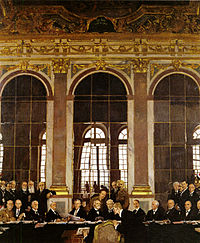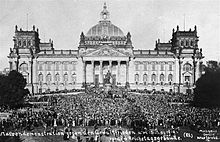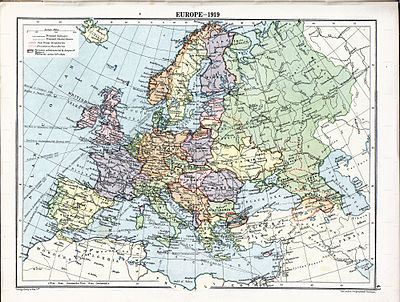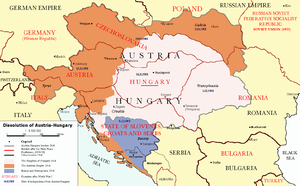Aftermath of World War I - Picture
More about World War 1

|
|
Aftermath of World War I

Picture - Signing of the Treaty of Versailles in the Hall of Mirrors at the Palace of Versailles in 1919.
The fighting in World War I ended in western Europe when the Armistice took effect at 11:00 am GMT on November 11, 1918, and in eastern Europe by the early 1920s. During and in the aftermath of the war the political, cultural, and social order was drastically changed in Europe, Asia and Africa, even outside the areas directly involved in the war. New countries were formed, old ones were abolished, international organizations were established, and many new and old ideologies took a firm hold in people's minds.
Blockade of Germany
Throughout the period from the armistice on 11 November 1918 until the signing of the peace treaty with Germany on 28 June 1919, the Allies maintained the naval blockade of Germany that had begun during the war. As Germany was dependent on imports, it is estimated that 523,000 civilians had lost their lives during the war, and a quarter-million more died from disease or starvation in this eight month period.
The continuation of the blockade after the fighting ended, as Robert Leckie wrote in Delivered From Evil, did much to "torment the Germans ... driving them with the fury of despair into the arms of the devil." The terms of the Armistice did allow food to be shipped into Germany, but the Allies required that Germany provide the ships. The German government was required to use its gold reserves, being unable to secure a loan from the United States.
The blockade was not lifted until early July 1919 when the Treaty of Versailles was signed by most of the combatant nations.
Treaty of Versailles

Picture - Demonstration against the Treaty in front of the Reichstag building
After the Paris Peace Conference of 1919, the signing of the Treaty of Versailles on June 28, 1919, between Germany on the one side and France, Italy, Britain and other minor allied powers on the other side, officially ended war between those countries. Other treaties ended the belligerent relationships of the United States and the other Central Powers. Included in the 440 articles of Treaty of Versailles were the demands that Germany officially accept responsibility for starting the war and pay heavy economic reparations. This treaty drastically limited the German military machine: the German troops were reduced to 100,000 and the country was prevented from possessing major military armament such as tanks, warships, and submarines.
Influenza epidemic
A separate but related event was the great 1918 flu pandemic. A virulent new strain of the flu first observed in the United States but misleadingly known as the "Spanish flu", was accidentally carried to Europe by infected American forces personnel. One in every four Americans had contracted the influenza virus. The disease spread rapidly through both the continental U.S., Canada and Europe, eventually reaching around the globe, partially because many were weakened and exhausted by the famines of the World War. The exact number of deaths is unknown but about 50 million people are estimated to have died from the influenza outbreak worldwide. In 2005, a study found that, "The 1918 virus strain developed in birds and was similar to the 'bird flu' that today has spurred fears of another worldwide pandemic, yet proved to be a normal treatable virus that did not produce a heavy impact on the world's health."
Economic and Geopolitical consequences
There were some general consequences from the creation of a large number of new small states in eastern Europe as a result of the dissolution of the German, Russian, Austro-Hungarian and (a little earlier) Ottoman empires, and the regional disturbance of the Russian Civil War. Internally these new states tended to have substantial ethnic minorities, which wished to unite with neighbouring states where their ethnicity dominated. For example Czechoslovakia had Germans, Poles, Ruthenians and Ukrainians, Slovaks and Hungarians. Various League sponsored Minority Treaties expressed an attempt, albeit inadequate, to deal with this problem. One consequence of the massive redrawing of borders and the political changes in the aftermath of war was the large number of European refugees. These and the refugees of the Russian Civil War led to the creation of the Nansen passport.
Ethnic minorities made the location of the frontiers generally unstable. Where the frontiers have remained unchanged, since 1918, there has often been the expulsion of an ethnic group, such as the Sudeten Germans. Economic and military cooperation amongst these small states was minimal ensuring that the defeated powers of Germany and the Soviet Union retained a latent capacity to dominate the region. In the immediate aftermath of the war, defeat drove cooperation between Germany and the Soviet Union but ultimately these two powers would compete to dominate eastern Europe.
Revolutions

Picture - Political divisions of Europe in 1919 after the treaties of Brest-Litovsk and Versailles and before the treaties of Trianon, Kars, Riga and the creation of Soviet Union and the republics of Ireland and Turkey.
Perhaps the single most important event precipitated by the privations of World War I was the Russian Revolution of 1917. A socialist and often explicitly Communist revolutionary wave occurred in many other European countries from 1917 onwards, notably in Germany and Hungary.
As a result of the Russian Provisional Governments' failure to cede territory, German and Austrian forces defeated the Russian armies, and the new communist government signed the Treaty of Brest-Litovsk in March 1918. In that treaty, Russia renounced all claims to Estonia, Finland, Latvia, Lithuania, Ukraine, and the territory of Congress Poland and it was left to Germany and Austria-Hungary "to determine the future status of these territories in agreement with their population." Later on, Lenin's government renounced also the Partition of Poland treaty, making it possible for Poland to claim its 1772 borders. However, the Treaty of Brest-Litovsk was rendered obsolete when Germany was defeated later in 1918, leaving the status of much of eastern Europe in an uncertain position.
Germany
There was a socialist revolution which led to the brief establishment of a number of communist political systems in (mainly urban) parts of Germany, the abdication of the Kaiser, and the creation of the Weimar Republic.
On 28 June 1919, Germany, which was not allowed representation, was not present to sign the Treaty of Versailles. The oneside treaty by the victors placed blame for the entire war upon Germany (a view never accepted by German nationalists but argued by, inter alia, German historian Fritz Fischer). Germany was forced to pay 132 billion marks ($31.5 billion, 6.6 billion pounds) in reparations (a very large amount for its day which was finally paid off in October, 2010). It was followed by the Inflation in the Weimar Republic, a period of hyperinflation in Germany between 1921 and 1923. In this period the worth of fiat Papiermarks with respect to the earlier commodity Goldmarks was reduced to one trillionth (one million millionth) of its value. On December 1922 the Reparations Commission declared Germany in default, and on 11 January 1923 French and Belgian troops occupied the Ruhr until 1925.
Because Germany could mobilize the single strongest army in Europe-a possibility seen as an ongoing threat by France-blaming Germany for the war created a justification to force Germany to permanently reduce the size of its army to 100,000 men, renounce tanks and have no air force (her capital ships, moored in Scapa Flow, were scuttled by their crews).
Germany saw relatively small amounts of territory transferred to Denmark, Czechoslovakia, and Belgium, a larger amount to France and the greatest portion as part of re-established Poland. Germany's overseas colonies were divided amongst a number of Allied countries. It was the loss of territory that now constituted part of Poland that caused by far the greatest resentment. Nazi propaganda would feed on a general German view that the treaty was unfair-many Germans never accepted the treaty as legitimate, and later gave their political support to Adolf Hitler, who was arguably the first national politician to both speak out and take action against the treaty's conditions.
Russian Empire
Russia, already suffering socially and economically, was torn by a deadly civil war that left more than 5.5 million people dead and large areas of the country devastated.
During the Russian Revolution of 1917 and subsequent Russian Civil War, many non-Russian nations gained brief or longer lasting periods of independence. Finland, Lithuania, Latvia, and Estonia gained relatively permanent independence, although the Baltic states were annexed by the Soviet Union in 1940. Armenia, Georgia, and Azerbaijan were established as independent states in the Caucasus region. In 1922 these countries were proclaimed as Soviet Republics, and eventually absorbed into the Soviet Union. However, Turkey had by then captured Armenian territory around Artvin, Kars, and Igdir: these territorial losses would become permanent. Romania gained Bessarabia from Russia. After World War I, the Soviet Union was fortunate that Germany had lost the war as it was able to reject the Treaty of Brest-Litovsk.
Austria-Hungary
With the war having turned decisively against the Central Powers, the peoples of Austria-Hungary lost faith in their allied countries, and even before the armistice in November, radical nationalism had already led to several declarations of independence in south-central Europe in the time after November 1918. As the central government had ceased to operate in vast areas, these regions found themselves without a government and many new groups attempted to fill the void. During this same period, the population was facing food shortages and was, for the most part, demoralized by the losses incurred during the war. Various political parties, ranging from ardent nationalists, to social-democrats, to communists attempted to set up governments in the names of the different nationalities. In other areas, existing nation states such as Romania engaged regions that they considered to be theirs. These moves created de facto governments that complicated life for diplomats, idealists, and the western allies.
The Western forces were officially supposed to occupy the old Empire, but rarely had enough troops to do so effectively. They had to deal with local authorities who had their own agenda to fulfill. At the peace conference in Paris the diplomats had to reconcile these authorities with the competing demands of the nationalists who had turned to them for help during the war, the strategic or political desires of the Western allies themselves, and other agendas such as a desire to implement the spirit of the 14 points.
For example, in order to live up to the ideal of self determination laid out in the Fourteen Points, Germans, whether Austrian or German, should be able to decide their own future and government. However, the French especially were concerned that an expanded Germany would be a huge security risk. Further complicating the situation, delegations such as the Czechs and Slovenians made strong claims on some German-speaking territories.
The result was treaties that compromised many ideals, offended many allies, and set up an entirely new order in the area. Many people hoped that the new nation states would allow for a new era of prosperity and peace in the region, free from the bitter quarrelling between nationalities that had marked the preceding fifty years. This hope proved far too optimistic. Changes in territorial configuration after World War I included:
Establishment of the Republic of German Austria and the Hungarian Democratic Republic, disavowing any continuity with the empire and exiling the Habsburg family in perpetuity.
Borders of newly independent Hungary did not include two-thirds of the lands of the former Kingdom of Hungary, including large areas where the ethnic Magyars were in a majority. The new republic of Austria maintained control over most of the mostly German-dominated areas, but lost various other German majority lands in what was the Austrian Empire.

Picture - Division of Austria-Hungary after World War I.
Bohemia, Moravia, Opava Silesia and the western part of Duchy of Cieszyn, Slovakia and Carpathian Ruthenia formed the new Czechoslovakia.
Galicia, eastern part of Duchy of Cieszyn, northern County of Orava and northern Spisz was transferred to Poland.
the Southern half of the County of Tyrol and Trieste were granted to Italy.
Bosnia and Herzegovina, Croatia-Slavonia, Dalmatia, Slovenia, and Vojvodina were joined with Serbia to form the Kingdom of the Serbs, Croats and Slovenes, later Yugoslavia.
Transylvania and Bukovina became parts of Romania.
These changes were recognized in, but not caused by, the Treaty of Versailles. They were subsequently further elaborated in the Treaty of Saint-Germain and the Treaty of Trianon.
The new states of eastern Europe nearly all had large national minorities. Millions of Germans found themselves in the newly created countries as minorities. One third of ethnic Hungarians found themselves living outside of Hungary. Many of these national minorities found themselves in bad situations because the modern governments were intent on defining the national character of the countries, often at the expense of the other nationalities.
The interwar years were hard for the Jews of the region. Most nationalists distrusted them because they were not fully integrated into 'national communities'. In contrast to times under the Austro-Hungarian monarchy, Jews were often ostracized and discriminated against. Although anti-Semitism had been widespread during Habsburg rule, Jews faced no official discrimination because they were, for the most part, ardent supporters of the multi-national state and the monarchy. Jews had feared the rise of ardent nationalism and nation states, because they foresaw the difficulties that would arise.
The economic disruption of the war and the end of the Austro-Hungarian customs union created great hardship in many areas. Although many states were set up as democracies after the war, one by one, with the exception of Czechoslovakia, they reverted to some form of authoritarian rule. Many quarreled amongst themselves but were too weak to compete effectively. Later, when Germany rearmed, the nation states of south- central Europe were unable to resist its attacks, and fell under German domination to a much greater extent than had ever existed in Austria-Hungary.
Ottoman Empire
At the end of the war, the Allies occupied Istanbul and the Ottoman government collapsed. The Treaty of Sx¨vres, a plan designed by the Allies to dismember the remaining Ottoman territories, was signed on August 10, 1920, though never ratified by the Sultan.
The occupation of Izmir by Greece on May 19, 1919, triggered a nationalist movement to rescind the terms of the treaty. Turkish revolutionaries led by Mustafa Kemal Ataturk, a successful Ottoman commander, rejected the terms enforced at Sx¨vres and under the guise of General Inspector of the Ottoman Army, left Istanbul for Samsun to organize the remaining Ottoman forces to resist the terms of the treaty. On the eastern front, the defeat of the Armenian forces in the Turkish-Armenian War and signing of the Treaty of Kars with the Soviet Union recovered territory lost to Armenia and Imperial Russia.
On the western front, the growing strength of the Turkish nationalist forces led Greece, with the backing of Britain, to invade deep into Anatolia in an attempt to deal a blow to the revolutionaries. At the Battle of Sakarya, the Greek army was defeated and forced into retreat, leading to the recovery of Izmir and withdrawal of Greece from Asia Minor. With the nationalists empowered, the army marched on to reclaim Istanbul, resulting in the Chanak crisis in which the British Prime Minister, David Lloyd George, was forced to resign. After Turkish resistance gained control over Anatolia and Istanbul, the Sx¨vres treaty was superseded by the Treaty of Lausanne which formally ended all hostilities and led to the creation of the modern Turkish Republic. As a result, Turkey became the only power of World War I to overturn the terms of its defeat, and negotiate with the Allies as an equal.
The Lausanne Treaty formally acknowledged the new League of Nations mandates in the Middle East, the cession of their territories on the Arabian Peninsula, and British sovereignty over Cyprus. The League of Nations granted Class A mandates for the French Mandate of Syria and Lebanon and British Mandate of Mesopotamia and Palestine, the later comprising two autonomous regions: Mandate Palestine and Transjordan). Parts of the Ottoman Empire on the Arabian Peninsula became part of what is today Saudi Arabia and Yemen. The dissolution of the Ottoman Empire became a pivotal milestone in the creation of the modern Middle East, the result of which bore witness to the creation of new conflicts and hostilities in the region.
United Kingdom
In the United Kingdom, funding the war had a severe economic cost. From being the world's largest overseas investor, it became one of its biggest debtors with interest payments forming around 40% of all government spending. Inflation more than doubled between 1914 and its peak in 1920, while the value of the Pound Sterling (consumer expenditure ) fell by 61.2%. Reparations in the form of free German coal depressed the local industry, precipitating the 1926 General Strike.
British private investments abroad were sold, raising £550 million. However, £250 million new investment also took place during the war. The net financial loss was therefore approximately £300 million; less than two years investment compared to the pre-war average rate and more than replaced by 1928. Material loss was "slight": the most significant being 40% of the British merchant fleet sunk by German U-boats. Most of this was replaced in 1918 and all immediately after the war. The military historian Correlli Barnett has argued that "in objective truth the Great War in no way inflicted crippling economic damage on Britain" but that the war "crippled the British psychologically but in no other way".
Less concrete changes include the growing assertiveness of Commonwealth nations. Battles such as Gallipoli for Australia and New Zealand, and Vimy Ridge for Canada led to increased national pride and a greater reluctance to remain subordinate to Britain, leading to the growth of diplomatic autonomy in the 1920s. These battles were often decorated in propaganda in these nations as symbolic of their power during the war. Traditionally loyal dominions such as Newfoundland were deeply disillusioned by Britain's apparent disregard for their soldiers, eventually leading to the unification of Newfoundland into the Confederation of Canada. Colonies such as India and Nigeria also became increasingly assertive because of their participation in the war. The populations in these countries became increasingly aware of their own power and Britain's fragility.
In Ireland the delay in finding a resolution to the home rule issue, partly caused by the war, as well as the 1916 Easter Rising and a failed attempt to introduce conscription in Ireland, increased support for separatist radicals, and led indirectly to the outbreak of the Irish War of Independence in 1919. The creation of the Irish Free State that followed this conflict in effect represented a territorial loss for the United Kingdom that was all but equal to the loss sustained by Germany (and furthermore, compared to Germany, a much greater loss in terms of its ratio to the country's prewar territory).
United States
The Espionage Act of 1917 stayed on the lawbooks; over the years it is used against hundreds of spies, but also leakers and whistleblowers, such as Ellsberg and Russo in the 1970s.
Disillusioned by the failure of the war to achieve the high ideals promised by President Woodrow Wilson, however, American commercial interests did finance Europe's rebuilding and reparations efforts in Germany, at least until the onset of the Great Depression. The American economic influence allowed the Great Depression to start a domino affect, pulling Europe in as well.
France
France annexed the Independent Republic of Alsace-Lorraine, the country which had been established in the wake of Kaiser Wilhelm II's abdication, corresponding to the region which had been ceded to the German Empire during the 1870 Franco-Prussian War. At the 1919 Peace Conference, Prime Minister Clemenceau's aim was to ensure that Germany would not seek revenge in the following years. To this purpose, the chief commander of the Allied forces, Field Marshal Ferdinand Foch, had demanded that for the future protection of France the Rhine river should now form the border between France and Germany. Based on history, he was convinced that Germany would again become a threat, and, on hearing the terms of the Treaty of Versailles that had left Germany substantially intact, he observed that "This is not Peace. It is an Armistice for twenty years."
The destruction brought upon the French territory was to be indemnified by the reparations negotiated at Versailles. This financial imperative dominated France's foreign policy through-out the 1920s, leading to the 1923 Occupation of the Ruhr in order to force Germany to pay. However, Germany was unable to pay, and obtained support from the United States. Thus, the Dawes Plan was negotiated after President Raymond Poincaré's occupation of the Ruhr, and then the Young Plan in 1929.
Also extremely important in the War was the participation of French colonial troops, including the Senegalese tirailleurs, from Indochina, North Africa, and Madagascar. When these soldiers returned to their homelands and continued to be treated as second class citizens, many became nuclei of pro-independence groups.
Furthermore, under the state of war declared during the hostilities, the French economy had been somewhat centralized in order to be able to shift into a "war economy", leading to a first breach with classical liberalism.
Finally, the socialists's support of the National Union government (including Alexandre Millerand's nomination as Minister of War) marked a shift towards the French Section of the Workers' International's (SFIO) turn towards social democracy and participation in "bourgeois governments", although Léon Blum maintained a socialist rhetoric.
Italy
After the war, Italy failed to annex Dalmatia (which had been promised by Britain and France in the Treaty of London to induce Italy to join the war), and had to fight some more years to annex the city of Fiume, which had an Italian population, and this led several Italian politicians to speak of a "mutilated victory.".
Indeed, it should not have been difficult to see how, among the Allied Powers, Italy had been the one which benefited the most from the outcome of the war. Whereas Britain and France still faced a Germany which had kept about 80 percent of its industrial and economic potential and thus could attempt a revanche in a matter of years, Italy had definitively rid itself of its century-old enemy: instead of the Austro-Hungarian Empire there were now a number of smaller states, none of which could pose a credible threat, and some of them could even fall within the Italian sphere of influence.
With the annexation of Istria, Trentino-Alto Adige/Sudtirol, Trieste, Zara and some Dalmatian islands, Italy had a substantial territorial expansion and could now rely on secure borders, although in presence of strong minorities near to the borders with Austria and Yugoslavia. Furthermore, Italian sovereignty over Rhodes and the Dodecanese had been officially recognized, as well as the Italian special interests in Albania. However, a Yugoslavian state was created in order to bar Italian influence and expansion on the Balkans, and thus Italy was quite isolated in this area. The Italian politicians failed to perceive the positive elements of the peace treaties and stressed the negative ones, and so the myth of the "mutilated victory" spread, fueling the Fascist propaganda and helping Benito Mussolini seize power.
During the war, Italy had suffered more casualties than Britain and fewer than France, and the social problems she was facing afterward (an inflated war industry to reconvert to civilian production, the large number of crippled people no longer able to sustain themselves, the new role of women) were common to other Allied countries which, however, did not suffer an authoritarian drift. The difference between Italy and the other western allies lies in the more arbitrated economic and social conditions, which made it more difficult for Italy to recover from similar difficulties. Due to similar reasons, most south and east European countries had to face political unrest, dictatorship and fascism in the period between the World Wars.
China
The Republic of China who hoped to retake the Jiaozhou Bay occupied by Germany between 1898 and 1914 suffered diplomatic failure at the Paris Peace Conference, 1919. The Chinese delegation also called for an end to Western imperialistic institutions in China, which was refused. Despite sending thousands of labourers to France during the war, China as an allied nation was refused the demand for the return of Jiaozhou Bay and the city was instead transferred to Japanese rule. This led to the May Fourth Movement, a profound social and political movement often cited as the birth of Chinese nationalism, which both the Kuomintang and Chinese Communist Party consider an important period in their history. Subsequently, China did not sign the treaty, signing a separate peace treaty with Germany in 1921.
Territorial gains and losses
Nations that gained territory after World War I
Yugoslavia (as the successor state of the Kingdom of Serbia)
Romania
Greece
France
Italy
Denmark
Belgium
Czechoslovakia
Poland
Estonia
Latvia
Lithuania
United Kingdom - League of Nations Mandates
Japan
Nations that lost territory after World War I
China - Jiaozhou Bay and most of Shandong in North China forcibly ceded to the Japanese Empire
Russian SFSR (as the successor state of the Russian Empire)
Weimar Germany (as the successor state of the German Empire)
Austria (as the successor state of Cisleithania and the Austro-Hungarian Empire)
Hungary (as the successor state of Transleithania and the Austro-Hungarian Empire)
Turkey (as the successor state of the Ottoman Empire)
Bulgaria
United Kingdom - most of Ireland as the Irish Free State
Social trauma
The experiences of the war in the west are commonly assumed to have led to a sort of collective national trauma afterward for all of the participating countries. The optimism of 1900 was entirely gone and those who fought in the war became what is known as "the Lost Generation" because they never fully recovered from their experiences. For the next few years, much of Europe mourned privately and publicly; mourning and memorials were erected in thousands of villages and towns.
So many British men of marriageable age died or were injured that the students of one girls' school were warned that only 10% would marry. The 1921 United Kingdom Census found 19,803,022 women and 18,082,220 men in England and Wales, a difference of 1.72 million which newspapers called the "Surplus Two Million". In the 1921 census there were 1,209 single women aged 25 to 29 for every 1,000 men. In 1931 50% were still single, and 35% of them never married while still able to bear children.
On the other hand, some people argue that it is not at all clear that any society was traumatised. Nor that the human losses were heavily mourned. This was the later view in the West, during the 1930s, because by then the Great Depression and the rise of Nazism made the sacrifices of the First World War seem meaningless. This was not clear in the 1920s. Neither Hitler's Germany nor the Soviet Union displayed any evidence that the First World War was at all traumatic. For Germany, the Soviet Union and all the new states the First World War had been the creation of the old political order and, as such, had little effect on the political elites of these countries. The real trauma for the British political class was the possibility of any future war.
As early as 1923, Stanley Baldwin had recognised a new strategic reality that faced Britain in a Disarmament Speech. Poison gas and the aerial bombing of civilians were new developments of the First World War. The British civilian population had not, for centuries, had any reason to fear invasion. So the new threat of poison gas dropped from enemy bombers excited a grossly exaggerated view of the civilian deaths that would occur on the outbreak of any war. Baldwin expressed this in his statement that The bomber will always get through. The traditional British policy of a balance of power in Europe no longer safeguarded the British home population. Out of this fear came appeasement. It is notable that neither Baldwin nor Neville Chamberlain had fought in the war but the anti-appeasers Antony Eden, Harold Macmillan and Winston Churchill had fought.
One gruesome reminder of the sacrifices of the generation was the fact that this was one of the first times in warfare whereby more men had died in battles than to disease, which had been the main cause of deaths in most previous wars. The Russo-Japanese War was the first war where battle deaths outnumbered disease deaths, but it had been fought on a much smaller scale between just two nations.
This social trauma made itself manifest in many different ways. Some people were revolted by nationalism and what it had caused; so, they began to work toward a more internationalist world through organizations such as the League of Nations. Pacifism became increasingly popular. Others had the opposite reaction, feeling that only military strength could be relied on for protection in a chaotic and inhumane world that did not respect hypothetical notions of civilization. Certainly a sense of disillusionment and cynicism became pronounced. Nihilism grew in popularity. Many people believed that the war heralded the end of the world as they had known it, including the collapse of capitalism and imperialism. Communist and socialist movements around the world drew strength from this theory, enjoying a level of popularity they had never known before. These feelings were most pronounced in areas directly or particularly harshly affected by the war, such as central Europe, Russia and France.
Artists such as Otto Dix, George Grosz, Ernst Barlach, and Kx¤the Kollwitz represented their experiences, or those of their society, in blunt paintings and sculpture. Similarly, authors such as Erich Maria Remarque wrote grim novels detailing their experiences. These works had a strong impact on society, causing a great deal of controversy and highlighting conflicting interpretations of the war. In Germany, nationalists including the Nazis believed that much of this work was degenerate and undermined the cohesion of society as well as dishonouring the dead.
Remains of ammunition

Picture - Iron harvest World War I ordnance left beside a field for disposal by the army in 2004 near Ypres in Belgium.
Throughout the areas where trenches and fighting lines were located, such as the Champagne region of France, quantities of unexploded shells and other ammunition have remained, some of which remains dangerous, continuing to cause injuries and occasional fatalities in the 21st century. Some are found by farmers ploughing their fields and have been called the iron harvest. Some of this ammunition contains chemical toxic products such as mustard gas. Cleanup of major battlefields is a continuing task with no end in sight for decades more. Squads remove, defuse or destroy hundreds of tons of unexploded ammunition every year in Belgium, France, and Germany.
Memorials

Picture - The Menin Gate Memorial, in Ypres, Belgium.
War memorials
Many towns in the paticipating countries have war memorials dedicated to local residents who lost their lives. Examples include:
Australian War Memorial, Canberra, Australia
Liberty Memorial, Kansas City, Missouri, United States
District of Columbia War Memorial, Washington, DC, United States
Beaumont-Hamel Newfoundland Memorial
The Cenotaph, London, United Kingdom
Menin Gate Memorial, Ypres, Belgium
Thiepval Memorial
Tyne Cot Memorial to the Missing at Passchendaele
Verdun Memorial Museum
Vimy Ridge Memorial, Vimy, France
Gallipoli Memorial, Turkey
Shrine of Remembrance, Melbourne, Australia
Island of Ireland Peace Park, Messines, Belgium
National War Memorial, Ottawa, Canada
National War Memorial, St. John's, Newfoundland, Canada
Tombs of Unknown Soldiers

Picture - The Amar Jawan Jyoti (the flame of the immortal warrior) in Delhi, India.
Monument to the Unknown Hero, Belgrade, Serbia
Amar Jawan Jyoti, New Delhi, India
Tomb of the Unknown Soldier, Ottawa, Canada
Arc de Triomphe, Paris, France
The Tomb of the Unknown Warrior is in Westminster Abbey, London, UK
Tomb of the Unknowns, Arlington National Cemetery, Virginia, United States
Tomba del milite ignoto, Rome, Italy
Australian War Memorial, Canberra, Australia
New Zealand Tomb of the Unknown Warrior, Wellington, New Zealand
Tomb of the Unknown Soldier, Syntagma Square, Athens, Greece
Tomb of the Unknown Soldier, Bucharest, Romania
List of people associated with World War I
Surviving veterans of World War I
Revolutions of 1917-23
Resources
Peacemakers: The Paris Peace Conference of 1919 and Its Attempt to End War by Margaret MacMillan, John Murray ISBN 0-7195-5939-1
Peacemaking, 1919 by Harold Nicolson ISBN 1-931541-54-X
Hew Strachan ed.: "The Oxford Illustrated History of the First World War" is a collection of chapters from various scholars that survey the War.
The Wreck of Reparations, being the political background of the Lausanne Agreement, 1932 by Sir John Wheeler-Bennett New York, H. Fertig, 1972.
The first major television documentary on the history of the war was the BBC's The Great War (1964), made in association with the Canadian Broadcasting Corporation, the Australian Broadcasting Corporation and the Imperial War Museum. The series consists of 26 forty-minute episodes featuring extensive use of archive footage gathered from around the world and eyewitness interviews. Although some of the programme's conclusions have been disputed by historians it still makes compelling and often moving viewing.
Other television documentaries of note on the conflict include World War One (1964) by CBS; The First World War (2004), based on Hew Strachan's works, and The Great War and the Shaping of the 20th Century (1996), shown o
More aircraft.
Source: WikiPedia